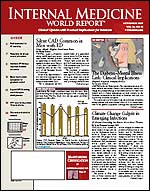Publication
Article
Internal Medicine World Report
A Looming Epidemic of Thyroid Nodules: Role of the Primary Care Physician
Author(s):
By Laura Brasseur
NEW YORK CITY—Because thyroid nodules are more common as we age, and the number of older Americans is rising constantly, "The epidemic is truly ahead of us," said Erik K. Alexander, MD, of Brigham & Women's Hospital, Boston, at the recent American Thyroid Association (ATA) meeting.
IMWR
Many primary care physicians neglect to evaluate the thyroid on a routine basis. How often do you palpate a patient's thyroid? "The job of the primary care physician is first, to palpate the patient's thyroid," David S. Cooper, MD, director, Division of Endocrinology, Sinai Hospital, Baltimore, and professor of medicine, Johns Hopkins University School of Medicine, told . "I can't tell you how many patients I see who are discovered to have thyroid problems and who say that their doctors have never felt their thyroid before."
David S. Cooper, MD
IMWR
"Further assessment is indicated once you think you can palpate any nodule that is 1 cm or greater," Dr Alexander told . Some data suggest a need for workup "if you feel any asymmetry or abnormality to the gland itself, even if you don't distinctly feel a nodule per se," he adds.
However, many thyroid nodules that are being worked up today are nonpalpable and are discovered by accident when a patient is referred for magnetic resonance imaging of the spine, because of tingling in the patient's arm, for example, or for imaging studies to check the patency of the carotid arteries.
This is why, Dr Cooper adds, "It's important for the primary care physician to know how to evaluate a nodule that is not palpable, just as it is to evaluate a nodule that is palpable." When an incidental nodule is discovered, the physician must order an ultrasound that is dedicated to the thyroid, "Because only then can you look for the ultrasound characteristics that are predictive of malignancy."
But even ultrasound characteristics are not always reliable, which is why the ATA recommends biopsy with fine-needle aspiration for most nodules sized >1.0 to 1.5 cm.
Thyroid nodules >1 cm: risk factors for malignancy
Age
<30 years, 15%-30% risk
30-60 years, 8%-15% risk
>60 years, believed to increase risk, but current data inconsistent
Gender
Men are at 1.5- to 2.0-fold greater risk
Ionizing radiation exposure in childhood
First-degree relative with a genetic syndrome that increases the risk of thyroid cancer
Family history of papillary carcinoma (especially in first-degree relative)
Symptoms*
Dysphagia
Dysphonia
Hyper/hypothyroidism
Pressure
Pain
Ultrasound features
Coarse/punctate calcification
Hypoechogenicity
Irregular nodule margin
Solitary nodule in euthyroid patient
History
*About 95% of patients with thyroid nodules will be asymptomatic.
This leads us to another "but": cytology will show no evidence of malignant cells in nearly 70% of cases. Of these, 5% will be positive for papillary carcinoma, and another 5% will be persistently nondiagnostic despite a second biopsy. In the remaining cases, cytology will report indeterminate findings. And as many as 45% of patients referred for thyroid surgery because of abnormal cytology will be found to have benign disease.
"Herein lies the dilemma of thyroid nodule evaluation. How often do we consider fine-needle aspiration?" Dr Alexander asks. There is no clear answer. Arguments against biopsy include:
- Most thyroid nodules are benign and asymptomatic
- Even if thyroid cancer develops, it probably will not shorten the patient's life span if left untreated
- Surgery is not without risks.
Proponents point out:
- Some 30,000 new cases of thyroid cancer occur in this country annually, and 2000 disease-related deaths
- Thyroid cancer is easily identifiable and treatable in its early stages.
But most experts agree that once you have assessed thyroid function and ordered an ultrasound for patients with a suspicious nodule, "They probably should be referred to an endocrinologist for further evaluation," said Dr Cooper.






